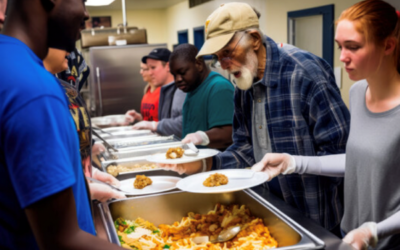What Millennials and Gen Z Expect of Quick Service Restaurants
As pioneers in the agile market research space, we know that people have been wanting things faster, cheaper, and better since about, well, forever. And just as timelines and budgets get smaller for brands and businesses, so often do they for individuals in their everyday lives. Whether on the go, during a hectic lunch hour, or at the end of a long day, even the most die hard of foodies often can’t find the time, resources, or energy to cook a whole meal. In fact, according to the American Customer Satisfaction Index, Americans are now spending more money dining out than shopping for groceries.
If restaurants and food vendors want to capitalize on this trend, they must address the needs expressed by their hungry customers. While quick service restaurants (QSR) have always answered the call for lower prices and speedy service, market research has revealed a growing concern among consumers for the nutritional benefits and quality of the food they crave from QSRs. So how can these restaurants effectively communicate the “freshness” of their offerings to their target audience of Millennials and Gen Z?
The Research
In order to understand what conveys quality to QSR customers, we launched an Exploratory Research Group* made up of both Gen Z (age 13-17) and Millennials (age 21-34) who eat at least occasionally if not more frequently at QSRs, and eat out of the house more than a few times per month. Our qualitative research was then guided by the following objectives:
- Explore unaided impressions of current QSR marketplace and behaviors
- Probe consumers’ understanding of “freshness”
- Uncover the primary drivers for QSR purchase
- Discover the ideal consumer vision for QSRs
The Results
Location, taste, and price drove most QSR choices.
When it comes to choosing a QSR over a full-service restaurant or eating at home, respondents noted physical convenience, particular cravings, and bargains as the primary drivers for QSR purchase. Initially, both groups ranked the health factor of QSRs as the lowest priority, suggesting that QSRs are not typically chosen for their nutritional quality. However, when sharing their favorite QSR brands, respondents did bring up freshness and taste as critical factors when faced with QSRs of similar convenience, food choice, and price range.
“Chick-fil-A has a friendly, welcoming atmosphere. The employees are super nice, they’re well-qualified, and the restaurant is always clean. The prices are generally more expensive than other fast food places, but the quality of the food makes up for that.” — Female, 16, Marietta, GA
Perceptions of freshness were driven by in-view prep and visible ingredient quality.
When it comes to freshness, respondents had to see it to believe it. Most indicated that freshness was conveyed by healthy fruit and vegetable offerings, described as “crisp,” “unprocessed,” and “just picked.” All respondents considered the freshness of food at QSRs to be important, and tended to rank chains with an image of mass-produced food much lower, believing they sacrificed quality as well as food safety. The easiest and most common way for respondents to tell if ingredients are fresh is by seeing them prepared upon ordering, and being able to “relate what the food looks like to foods found in nature,” as one respondent put it.
“A great way to know that a restaurant provides freshness is that it has an open kitchen concept and I can see the food being prepared. In-N-Out and Chipotle are two such establishments, I can see the ingredients being prepared and not just coming from a bag. It provides a transparency that earns my trust.” – Male, 29, Carson, CA
Millennials focused on cleanliness and non-frozen offerings, while Gen Z was more concerned with food temperature and the length of time from kitchen to customer.
Beyond visible impressions of ingredients, Millennials and Gen Z differed slightly on what ultimately conveys freshness to them. Millennials were concerned with the cleanliness of the restaurant and food prep area, as well as lack of preservation or freezing of ingredients. They relied more heavily on the overall atmosphere and food handling to believe in a QSR’s commitment to freshness. Gen Z, on the other hand, noted appropriate food temperature and how long it takes for their order to be prepared as reliable indicators of freshness. The standard that a meal be both made with quality ingredients as well as freshly prepared reveals that the quickness of QSRs must tread a fine line between speed and quality.
“[I like] In-N-Out because as soon as I bite into the burger you can taste everything that is inside and that is what fresh means to me. It is the overall quality of the food and as long as the quality is on point then I would say that it was fresh, because I could feel the heat from the burger and the coldness from the tomatoes.” – Female, 15, Santa Clara, CA
Consumers from both groups were interested in QSR loyalty programs, cash savings, and mobile ordering.
When asked to make suggestions or improvements to QSRs, most respondents brought up loyalty programs and technological advances. Consumers from both groups were focused on affordability, and indicated that deals, coupons, and rewards programs that offer cash savings (as opposed to a points system) would be the most intriguing to them. Each group said they liked the idea of an app for their favorite QSR, either for tracking loyalty programs and coupons, or for mobile ordering and pickup. Millennials were interested in more interaction with QSR brands through surveys and other feedback, while Gen Z just wanted more access to deals and faster ordering.
“Chick-fil-A recently came out with an app called Chick-fil-A One. This is similar to Starbucks’ mobile order. I haven’t tried out this app yet, but I’d like to try it out soon to see if it improves my experience. I would also love if they had a frequent buyer’s card- type thing, since I eat there so often.” – Female, 16, Marietta, GA
Freshness Should Be Something You Can See
According to both groups of respondents, freshness of food is heavily tied to its appearance and presentation. Millennials and Gen Z came up with mildly varying examples of how QSRs prove freshness to them, but the common thread through all of them is healthy produce and ingredients that are visible and cooked to order in a clean environment. Here are a few further implications for QSRs in terms of messaging, positioning, and product development.
1. A “fresh option” was interpreted by most to mean additional fruit and vegetable options, either as a new menu item or as optional add-ons to existing items. Though freshness was initially ranked lower among purchase drivers, it was revealed to be crucial to the overall quality and perception of a QSR brand.
2. Bright images of clean produce and specific language/terminology were suggested as ways for a QSR to demonstrate its commitment to serving fresh options. Since visual cues are so important to the impression of freshness, both groups thought such signage would be beneficial in advertising and in restaurants.
3. Consumers want more in-depth offerings in terms of mobile use, as well as increased interaction with QSR brands for the purpose of financial savings. Mobile ordering and apps for maintaining loyalty programs and coupons were high on the list of consumer demands, both for the purposes of saving more time and money.
As more and more Americans turn to QSRs to satisfy their needs for both speed and quality, such establishments should be aware of the importance of freshness in their overall brand perception among Millennials and Gen Z, and the steps in food offerings as well as product marketing that can communicate their commitment to quality. Download the research report below to learn more about respondents’ attitudes and behaviors surrounding QSRs, including
- Which meal of the day is most popular for QSR visits among respondents
- How respondents ranked specific QSRs by freshness and overall appeal
- Image uploads used by respondents to describe “freshness”
- How Millennials vs. Gen Z gauge freshness in different ways
- Menu suggestions respondents had for QSRs to increase their fresh options
*An Exploratory Research Group is an online qualitative research method where respondents interact with each other while answering open-ended questions and follow-ups posted by a trained moderator.
Want to stay up to date latest GutCheck blog posts?
Follow us on
Check Out Our Most Recent Blog Posts
When Vocation and Avocation Collide
At GutCheck, we have four brand pillars upon which we build our business. One of those is to 'lead...
Reflections on Season 1 of Gutsiest Brands
Understanding people is at the heart of market research. Sure, companies want to know what ideas...
Permission to Evolve with Miguel Garcia Castillo
(highlights from Episode #22 of the Gutsiest Brands podcast) Check out the latest lessons from our...
1-877-990-8111
[email protected]
© 2023 GutCheck is a registered trademark of Brainyak, Inc. All rights reserved.
© 2020 GutCheck is a registered trademark of Brainyak, Inc. All rights reserved.



